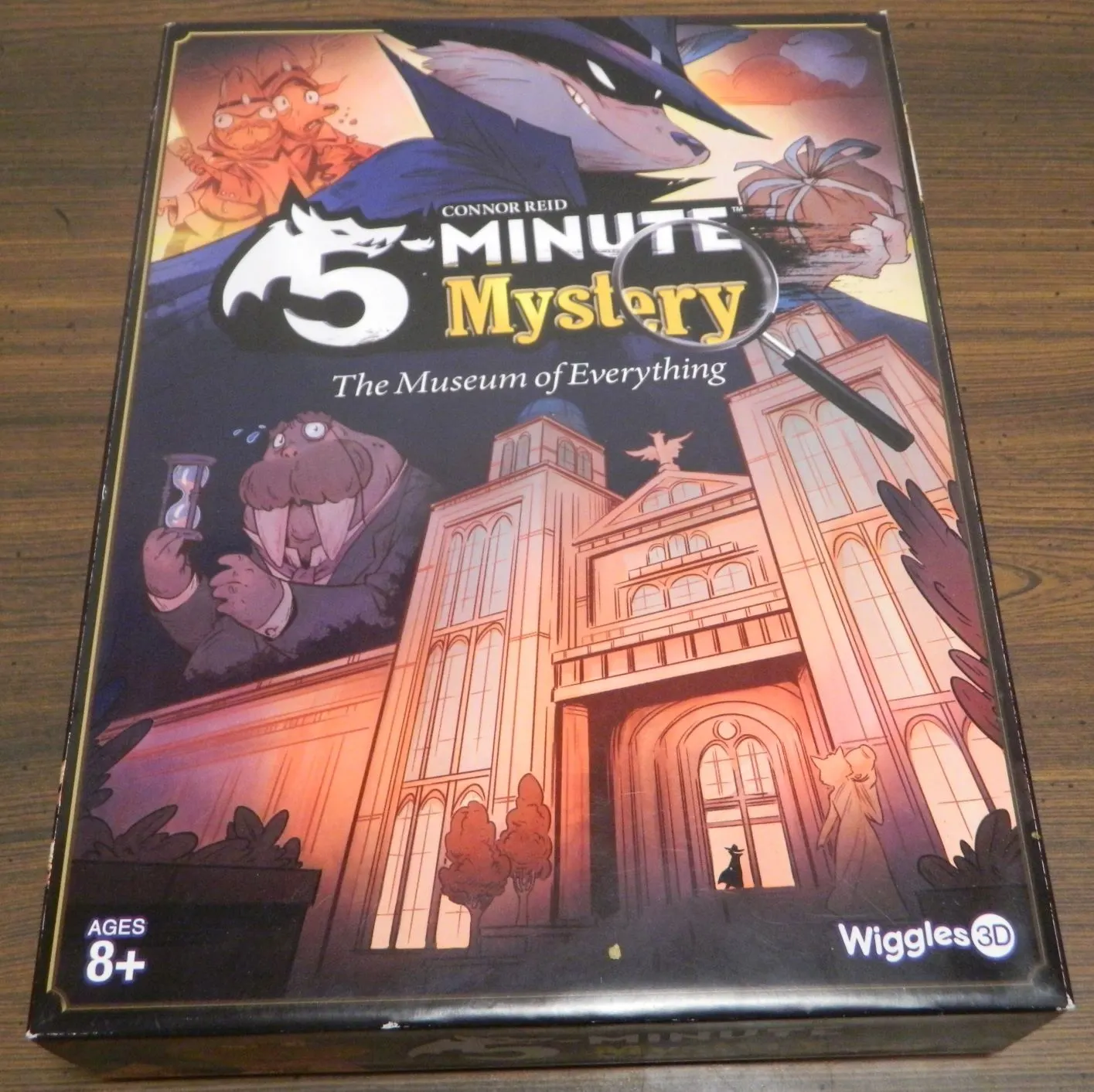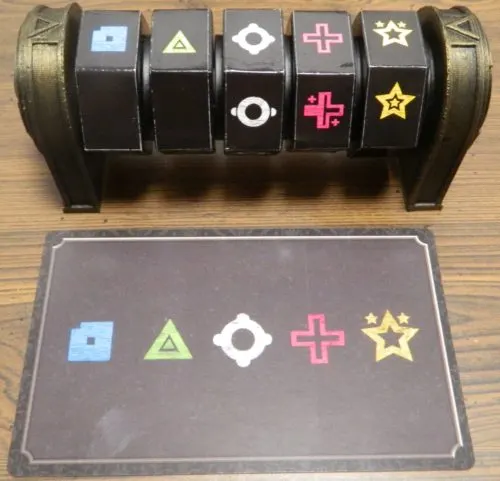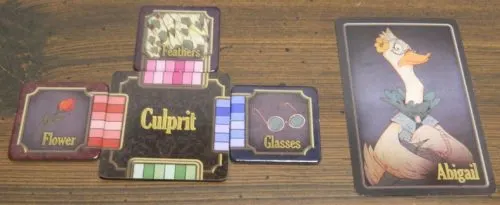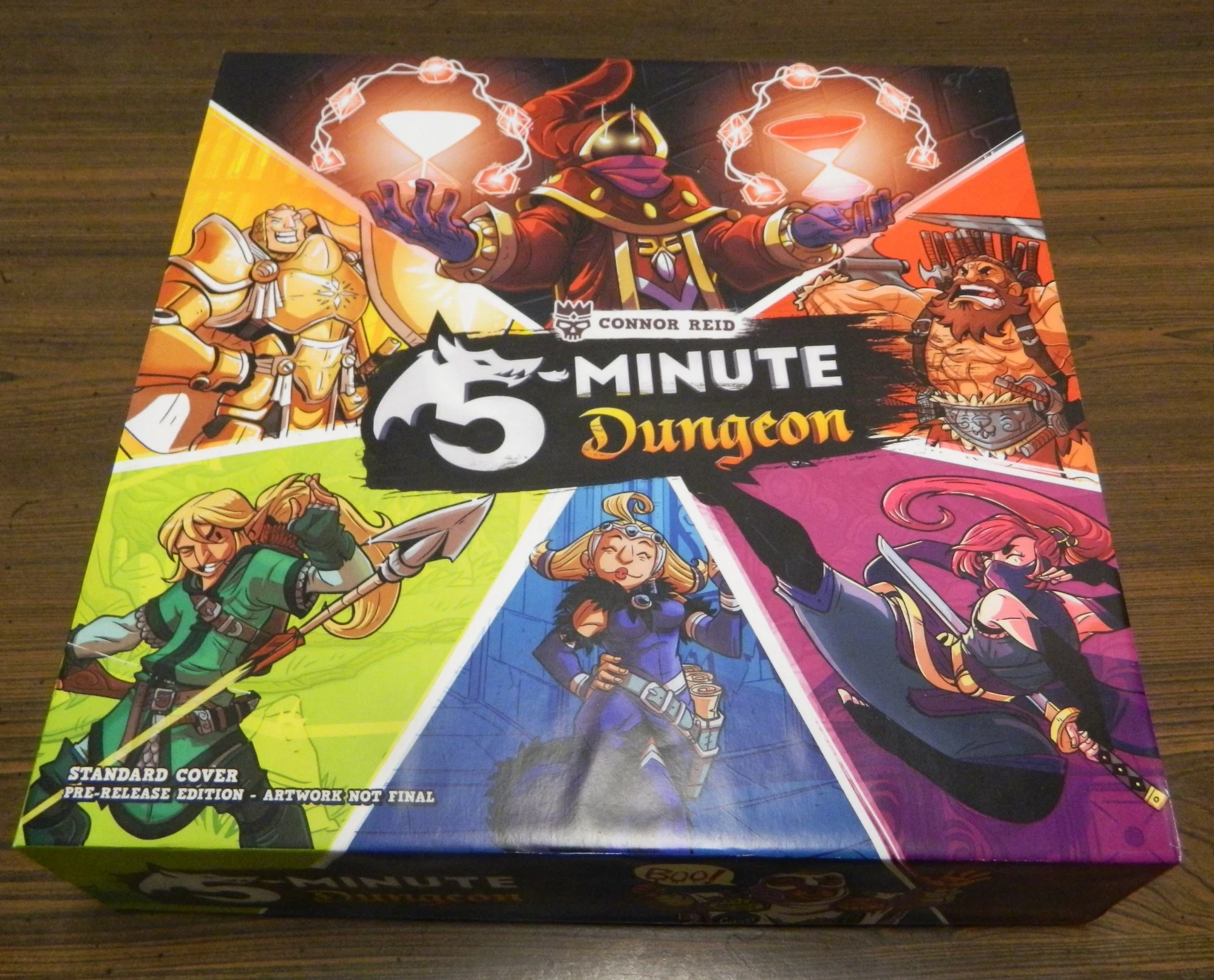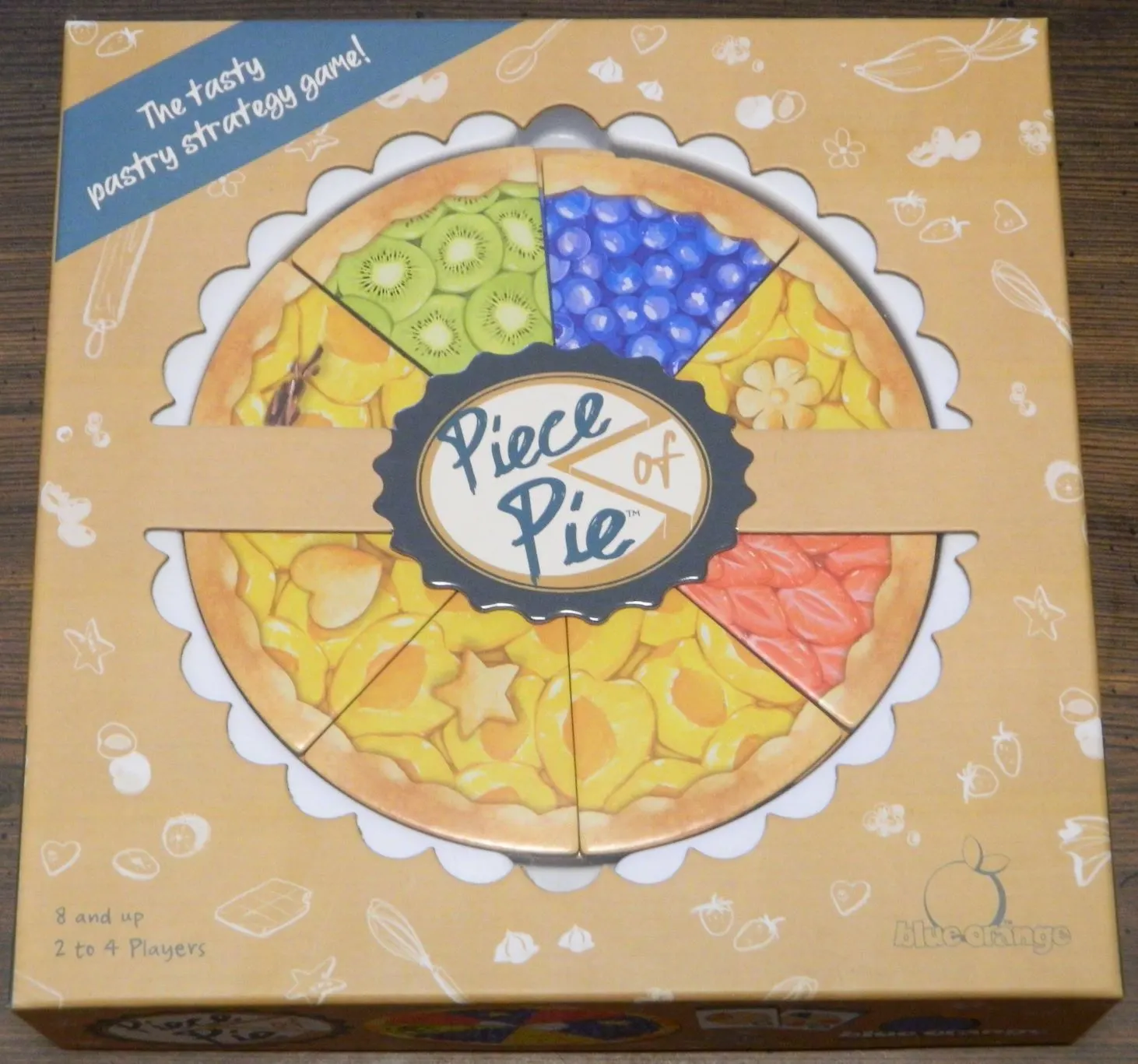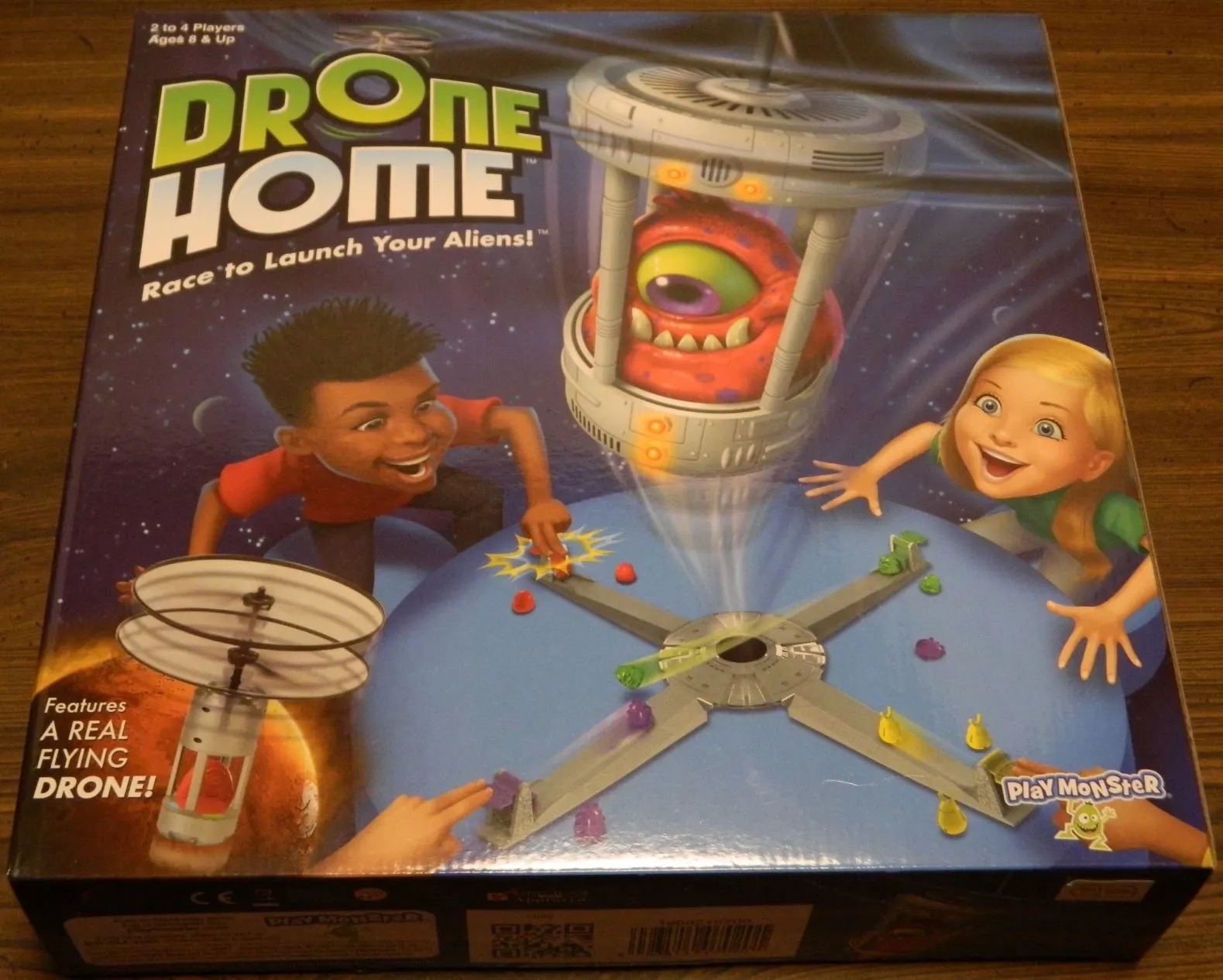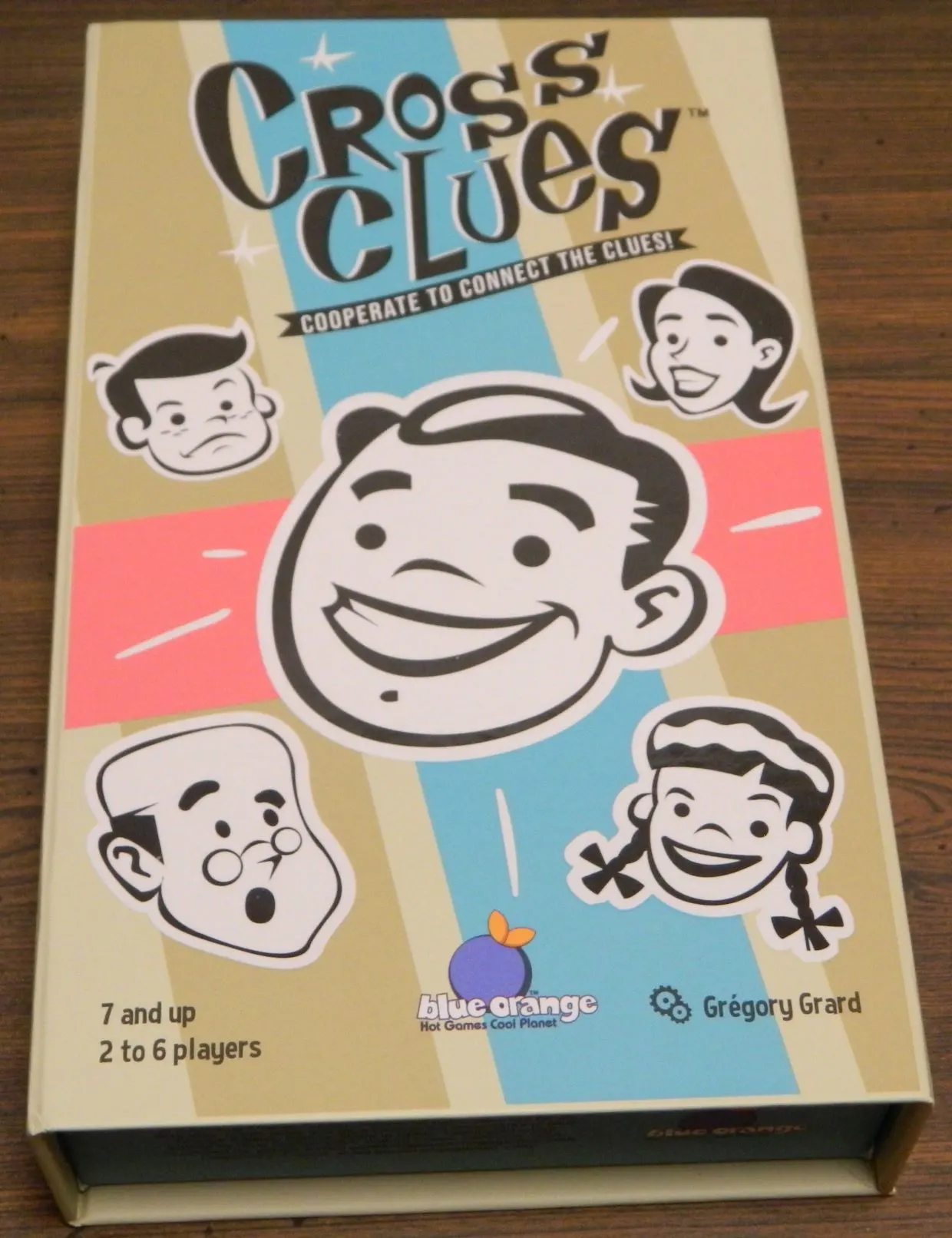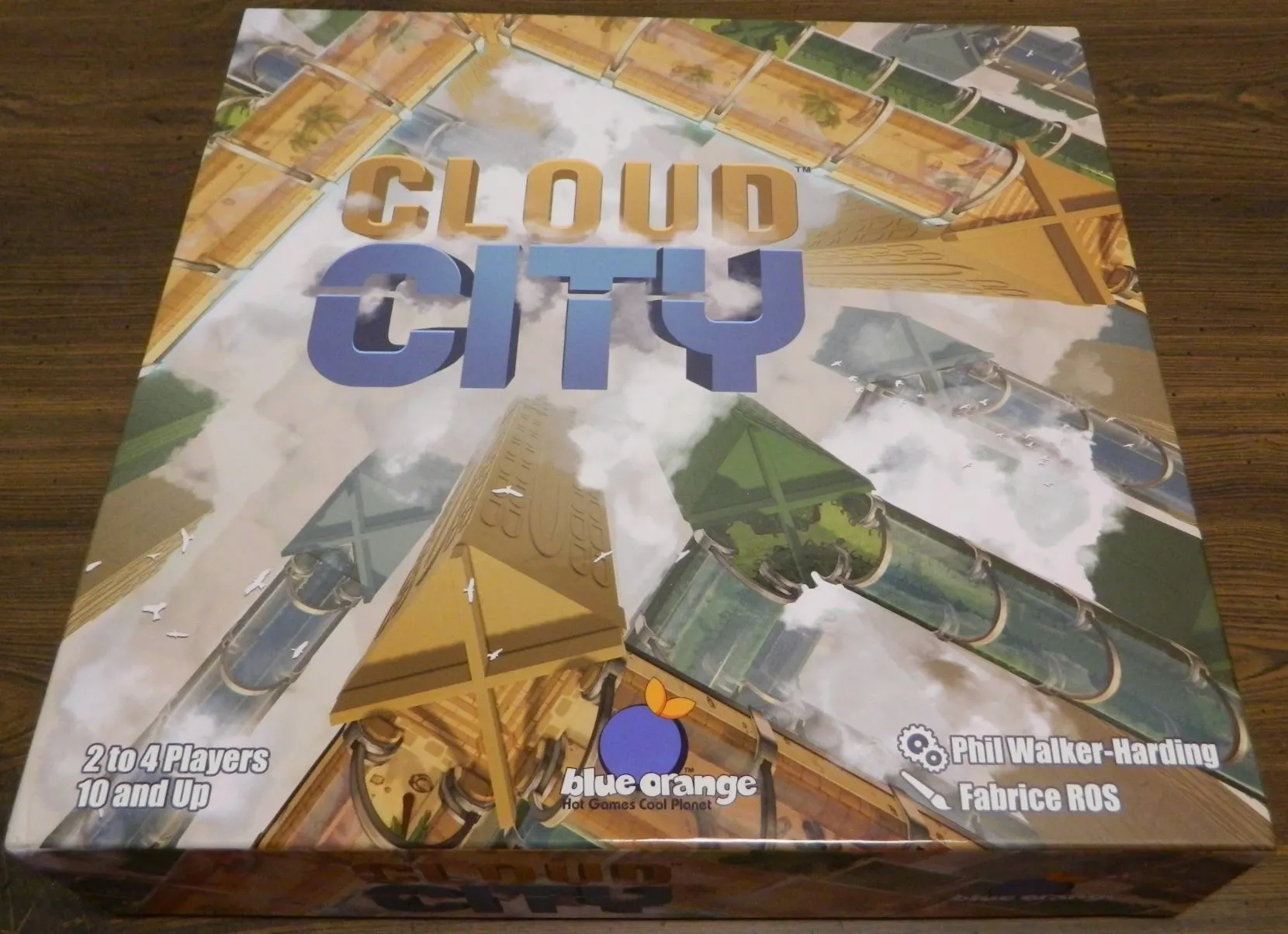Around three years ago I took a look at the speed card game 5-Minute Dungeon and a year and a half later I checked out its expansion pack Curses! Foiled Again!. When I saw the game’s concept I was immediately intrigued as it was such a unique concept mixing a card game with a speed game and adding in some dungeon crawling to spice things up. I had high expectations for 5-Minute Dungeon and yet the game still surpassed my expectations as it is one of the best card and speed games that I have ever played. When I was given the opportunity to check out the next game in the 5-Minute line I was excited to try it out as I have loved the other games in the series. With how well 5-Minute Dungeon combined speed and card game mechanics I was really interested in seeing what 5-Minute Mystery would do to combine a deduction game with a speed game. 5-Minute Mystery might not be quite as good as 5-Minute Dungeon, but it is a truly original combination of speed and deduction mechanics leading to a highly enjoyable game that the whole family should enjoy.
We would like to thank Wiggles 3D Incorporated for the review copy of 5-Minute Mystery used for this review. Other than receiving the review copy we at Geeky Hobbies received no other compensation. Receiving the review copy had no impact on the content of this review or the final score.
How to Play 5-Minute Mystery
This is a general overview of how to play 5-Minute Mystery. As this is based on a pre-release version of the game the rules won’t be exhaustive and may change before the final version is released. The pictures below also feature prototype components which may differ from the final version of the game.
Setup
- Shuffle the scene cards and place them in the middle of the table with the scene side face up. Choose which case you want to play and place the corresponding card on top of the scene pile. These case cards have special events/rules that you will follow for the game.
- Mix up the culprit tiles and choose one at random. This tile will be the culprit for the mystery. The tile will remain face down until the end of the mystery. The rest of the culprit tiles are returned to the box and players should not look at them.
- Divide the suspect cards between the players. Players can keep the cards in their hand, lay them face up on the table, or whatever the player wants.
- Separate the clue tiles by their colors and shuffle each group separately. Stack each set of tiles separately and place them face down on the table.
- Each player is given a reference card.
- All of the dials on the codex are set to the blank side. Choose which player will control the codex first.
- Set a timer to five minutes or whatever time is listed on the case file card. When players are ready you will start the timer and the game begins.
Playing the Game
The goal in 5-Minute Mystery is to figure out the identity of the face down culprit tile. The process of narrowing down the suspects comes down to two steps.
Hunting for Symbols
When the game begins you will remove the case card which will reveal the first scene card. The top scene card will display a scene. In this scene there will be five different types of symbols hidden within the picture. These symbols include a square, a circle, a triangle, a plus sign, and a star. Each picture will include a variant of all five symbols. Once the scene card is revealed all of the players will begin searching for the symbols. When one of the symbols is found the player who found it will have to describe it to the player with the codex so they can turn the corresponding dial to the correct symbol.
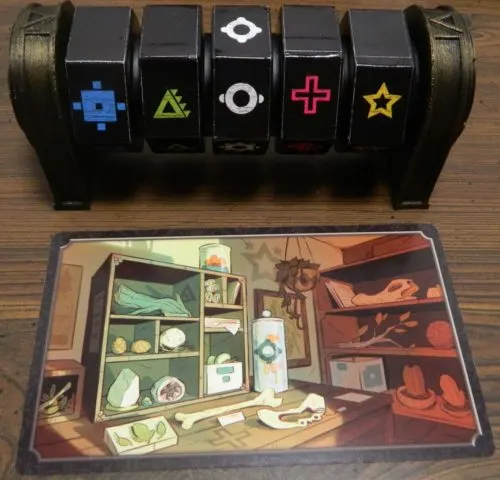
The players are looking for symbols in the scene card. In the middle of the picture on the white canister is the circle symbol. The players will turn the corresponding dial on the codex to match the symbol they have found.
When the players have found all five symbols and turned the dials on the codex to the correct symbols the players will submit their answer. The scene card is flipped over which will reveal the correct answer. The players will compare the symbols on the codex to the back of the scene card. If the players got all of the correct symbols they will get to take a clue (see below).
If the players got one or more symbols wrong they will fail the scene and get nothing.
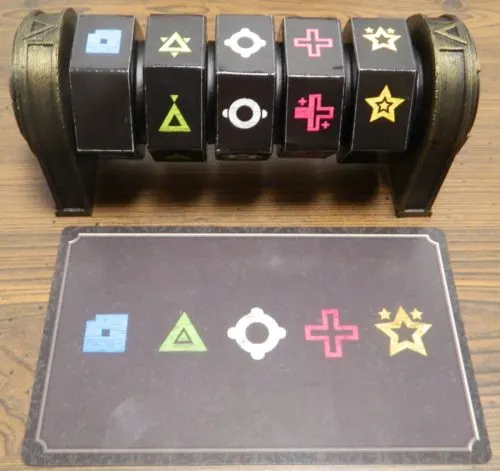
The players chose the wrong triangle symbol for this scene card. The players will not receive a clue tile for this scene.
In either case the players will then work on the next scene to hopefully get another clue. Before starting the next scene flip all of the dials on the codex to the blank side and pass it to the next player clockwise.
Clues
When a team successfully analyzes a scene they will get to take a clue tile. The players can choose which color clue they would like and take the top tile from the corresponding pile. The players will flip over the tile. The clue tile will either feature an object or a feature that describes the potential subjects.
The players will then compare the color barcode on the tile with the color barcode on the culprit tile. They will line up the clue tile next to the corresponding section of the culprit tile. If the two barcodes are exact matches it means that the clue tile describes the culprit. If the barcodes differ it means that the clue does not describe the culprit.
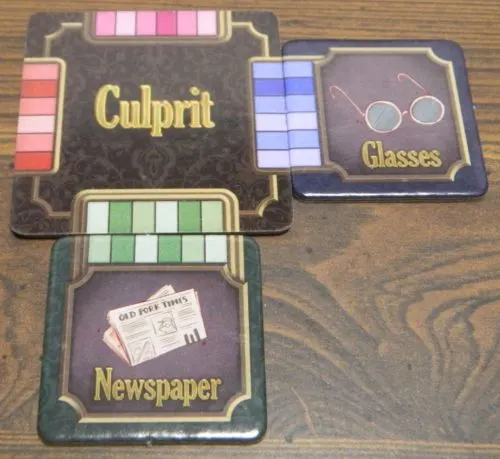
The players have acquired two clue tiles. The barcode on the glasses matches the culprit tile so the culprit will have glasses. The barcode on the newspaper does not match the culprit tile which means the culprit does not have a newspaper.
Based on the clue you received you can analyze your suspect cards and remove ones that don’t meet the clue you received.
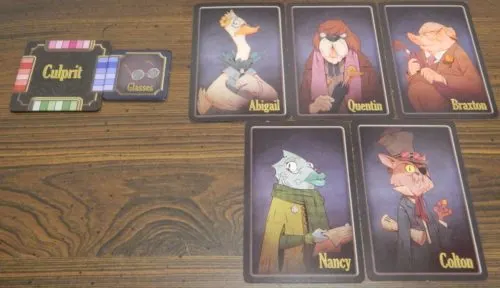
The players have received a clue that the culprit is wearing glasses. Thus they have eliminated all of the suspects that don’t have glasses.
End of Game
5-Minute Mystery can end in one of two ways.
- If the players are confident in who they think the culprit is they can make an arrest at any time.
- When the timer runs out the game ends immediately.
In either case the players will choose who they think is the culprit. If the players ran out of time they must make this decision from their remaining suspects without further analyzing the clues. Players will then turn over the culprit tile. If it matches the suspect they chose the players will win the game. If the culprit is a different suspect the players will lose the game.
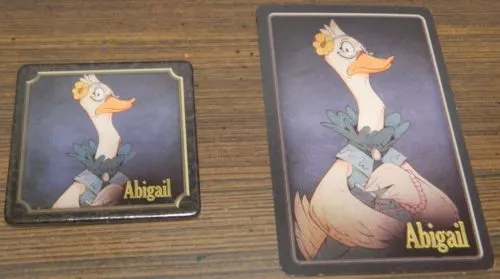
The players chose Abigail for the culprit. As Abigail was the culprit the players will win the game.
My Thoughts on 5-Minute Mystery
In 5-Minute Mystery you play as a group of detectives. The local museum is about to open their latest exhibit featuring the priceless MacGuffin. On the morning that the exhibit is supposed to debut it is discovered that the MacGuffin has gone missing. Sometime last night a burglar broke into the museum and stole it. You and your fellow detectives are called in to try and piece together what happened. The only clues left behind by the culprit are a set of mysterious symbols. You must decipher these symbols to find clues that will lead you to identifying the thief. The catch is the museum is about to open. Your team of detectives have five minutes to catch the thief and return the MacGuffin before the museum opens.
Like the other games in the 5-Minute franchise, I don’t think I have ever played a game quite like 5-Minute Mystery. The game features mechanics from several different board game genres and combines them into a truly unique experience. The simplest comparison that I can make is if you took Guess Who?, added in a Where’s Waldo?/hidden object mechanic, and topped that all off with having to complete everything within five minutes. That is an oversimplification of the game so lets take a more detailed look at each mechanic.
I would say that the main mechanic in 5-Minute Mystery is what I am going to refer to as the Where’s Waldo? mechanic. For those of you unfamiliar with Where’s Waldo? it is a series of books where you had to find certain characters or items hidden among a bunch of other characters and items. In 5-Minute Mystery instead of characters you are trying to find symbols hidden in plain sight. On each scene card there are five symbols that will be hidden in the background among the items. The players have to find all five symbols and input them into the codex. When they think they have the correct symbols they compare their choices to the solution to see if they were correct and whether they will get to take a clue that will lead them to the culprit. In action this plays a lot like the hidden object genre of video games.
When I was a kid I was a pretty big fan of Where’s Waldo? and the many ripoff books where you were tasked with finding things hidden in plain sight. I always thought this would make for a good board game mechanic as trying to find hidden objects is itself a fun activity. I have played a few games in the past that have utilized a similar mechanic. Some of these games were decent, but they never seemed to live up to the potential I had for the mechanic. This changed when I played 5-Minute Mystery.
While it is much easier to find the symbols in 5-Minute Mystery than Waldo in Where’s Waldo?, this mechanic is really fun. You have to find five different symbols in each picture and do it as quickly as possible because you are on a timer. The catch is that each type of symbol has variations. Thus the players have to clearly communicate to the player in control of the codex what the symbol is so they choose the correct one for the codex. This might seem kind of simple and it is. You can usually find the symbols pretty quickly as we regularly found all of the symbols on a card within around 30 seconds. That is kind of the point though as 5-Minute Mystery is a speed game. If it took a long time to find the symbols it would be hard to get enough clues to solve the case in time. I have always been a fan of this type of searching mechanic, and 5-Minute Mystery utilizes it perfectly. It is easily the best use of this type of mechanic that I have ever experienced in a board game.
So you have successfully found all of the correct symbols in one of the scenes. As a reward you get to take a clue tile. You choose a color of tile and flip over a tile of that color. The tile will feature an object that the culprit may have on them or a physical characteristic of the culprit. The tile also features a color coded bar on it that is compared to the same colored bar on the back of the culprit tile. If the two bars match you know that the clue points towards the culprit. If the bars don’t match it indicates that the culprit does not fit the clue. You use this information to narrow down the list of potential culprits.
Before reading the rules for 5-Minute Mystery I was really curious how the deduction aspect of the game would work. The game would only work if it could create a randomized mystery that everyone could work together to try and solve. Without randomized cases you would quickly run out of cases and eventually have to repeat them. Well 5-Minute Mystery succeeds in the task as every game will be a different mystery as you receive clues in a different order while also having a random culprit. This is due to the really clever addition of the color coded bars. These allow you to receive information about a random culprit without revealing their identity. Therefore everyone can play the game as no one has to be a bystander that hands out clues. How clues are given out in the game reminds me a lot of Guess Who?, but implemented a lot better. Basically each clue you receive should eliminate some of the suspects whether it describes or doesn’t describe the culprit. I recommend you be careful when analyzing the suspect cards though because the game can be kind of tricky as the relevant clue items/features can be hard to tell on a few of the cards unless you look at them closely. Just like the searching mechanic I found the deduction mechanic in 5-Minute Mystery to be quite fun.
Tying these two mechanics together is the ever ticking clock. As you have a limited amount of time you have to rush from searching through the scene cards to analyzing the clues that you recover. You have to move quickly as you don’t have a lot of extra time if you want to succeed. On their own the two mechanics I already mentioned are fun, but when you combine them together with the time limit they become even better. 5-Minute Mystery is a true race against the clock. As a fan of speed games I and the group that I played the game with had a lot of fun trying to find the symbols as quickly as possible in order to get more clues to discover the identity of the culprit. People who hate speed games may find this to be a little stressful, but I had a blast with it.
While I am on the topic of the time limit lets quickly talk about 5-Minute Mystery’s difficulty. Just like 5-Minute Dungeon I see 5-Minute Mystery being a great game for families and even adults that like a good speed or deduction game. 5-Minute Mystery’s rules are really easy to grasp where you can probably teach the game to new players within a couple minutes. None of the mechanics in the game are particularly difficult where I don’t see children having any problems with the game. The mechanics are simple but that doesn’t mean that the game will be boring for adults. I played the game with only a group of adults and we had a great time. The game finds a great balance between being simple enough for children and yet still being challenging enough to keep adults interested.
At times 5-Minute Dungeon could be kind of hard especially at the higher difficulty levels. In order to beat some of the more difficult bosses you needed to work really well together and have a little luck on your side. In general I would say that 5-Minute Mystery is a little easier. Instead of fighting different bosses you will play different scenarios in 5-Minute Mystery. Basically each scenario gives you your objectives for the game. These make each game a little different as they can change the amount of time you receive, impact the clues you receive, or throw some other wrinkles into the gameplay. For example one of the scenarios forces you find two suspects while another has you correctly solve ten scene cards instead of finding the culprit. These scenario cards bring quite a bit of variety to the game as they have a direct impact on what you will try to accomplish in the game. They also give you a way to adjust the difficulty. The difficulty seems to ramp up at a pretty steady pace where the first couple of scenarios are pretty easy which will be good for new players. The later scenarios can be quite difficult where they should test players that are quite good at the game.
I have really enjoyed my time playing 5-Minute Mystery. I can’t put my finger on exactly why but I will say that 5-Minute Mystery is not quite as good as 5-Minute Dungeon. It is close but I didn’t have quite as much fun with 5-Minute Mystery. 5-Minute Mystery is still a great game though that I had a blast playing. It is a unique experience as I can’t recall another game that I have played that is similar. The whole design of the game is really clever. Connor Reid (the designer) deserves a lot of credit for creating another great game. I think fans of 5-Minute Dungeon that think the concept of a speed deduction game sounds interesting should really enjoy 5-Minute Mystery.
5-Minute Mystery is a great game that I plan on adding to my board game rotation along with 5-Minute Dungeon. I had a couple minor issues with the game though.
I would say that the biggest “issue” with 5-Minute Mystery is that just like 5-Minute Dungeon it is one of those games that you aren’t going to play for hours at a time. This is partially due to each game only lasting around five minutes. You could easily play four to five games within a half hour. You will probably want to play those many games in a row too as the game can be pretty addicting at times. At the same time though you are mostly utilizing the same mechanics in each game so it will get a little repetitive after a while. I see 5-Minute Mystery as the type of game that you play for 30 minutes to an hour and then put it away for another day. It is a game that you will want to come back to on another day though.
The other issue has to deal with the components. Before I continue I will say that this review is utilizing a prototype copy of the game so things are prone to change before the final release. For the most part I actually really liked the components. Like 5-Minute Dungeon I love the game’s artwork. The artwork is great and it brings a lot of character to the game. The components also deserve credit as they allow you to quickly process whatever information you need so you can move quickly between searching the scenes and analyzing your clues. The overall quality of the components are also quite good.
Most of my issues with the components are kind of picky where they could be improved before the final version of the game. First I hope the game adds some more cards to the game. While it will take quite a bit of time to memorize where the symbols are hidden in the pictures, with enough games players will eventually start to figure out where to look for the symbols on the cards. The good news is that there is already a plan to add more suspects, scenes and case file cards to the final version. This should add more variety to the game. The other issues are mostly cosmetic. First the scene cards are a little small. They are not terribly small, but if people have eyesight problems or you are playing the game at a large table you may have some issues. At their current size the players have to sit pretty close to one another for everyone to see the cards. If this works for your group this isn’t really an issue. I think the cards should maybe be a little larger though. I wouldn’t make them too much larger though or it would be too easy to find the symbols hidden in the pictures. Otherwise on a couple of the scene cards it is a little hard to determine exactly which symbol is shown. There were a couple times where we didn’t know which of two symbols was actually shown in the picture so we had to make an educated guess.
Should You Buy 5-Minute Mystery?
Heading into 5-Minute Mystery I had high expectations due to how much I enjoyed 5-Minute Dungeon. I was really interested in 5-Minute Mystery because I wanted to see what it would do to combine deduction mechanics with a speed game. While it is not quite as good as 5-Minute Dungeon, 5-Minute Mystery is still a great game. The main gameplay of searching through the scene cards to find the hidden symbols is really fun and reminds me of Where’s Waldo? The deduction mechanics are quite clever as they utilize a Guess Who? type mechanic where you eliminate suspects based on the clues you receive. These two mechanics are complimented by the game utilizing a speed mechanic which keeps the gameplay flowing as you race to find as many clues as possible. With the simple yet satisfying gameplay the whole family can enjoy 5-Minute Mystery. It is more the type of game that you play for 30 minutes to an hour at a time, but it is a game that you will want to return to.
I really enjoyed my time with 5-Minute Mystery. It might not be quite as good as 5-Minute Dungeon, but it is still a very good game. People who enjoyed 5-Minute Dungeon or think the game’s concept sounds interesting should enjoy their time with 5-Minute Mystery. I would highly recommend that you consider picking up 5-Minute Mystery.
5-Minute Mystery’s Kickstarter campaign goes live tomorrow (November 26th, 2019). The game will retail for $35 CAD which is approximately $25 in the United States. Early pledges can save $5 on the purchase price. If you are interested in picking up 5-Minute Mystery you can find its’ Kickstarter page here.

